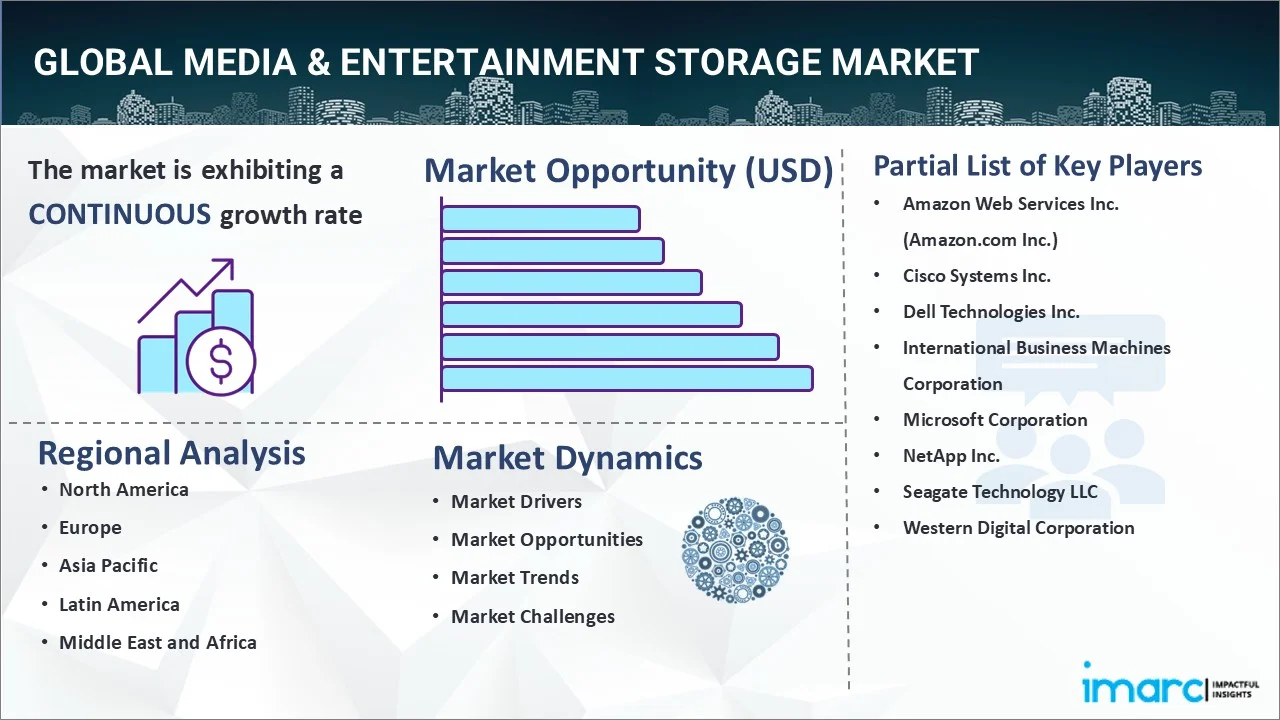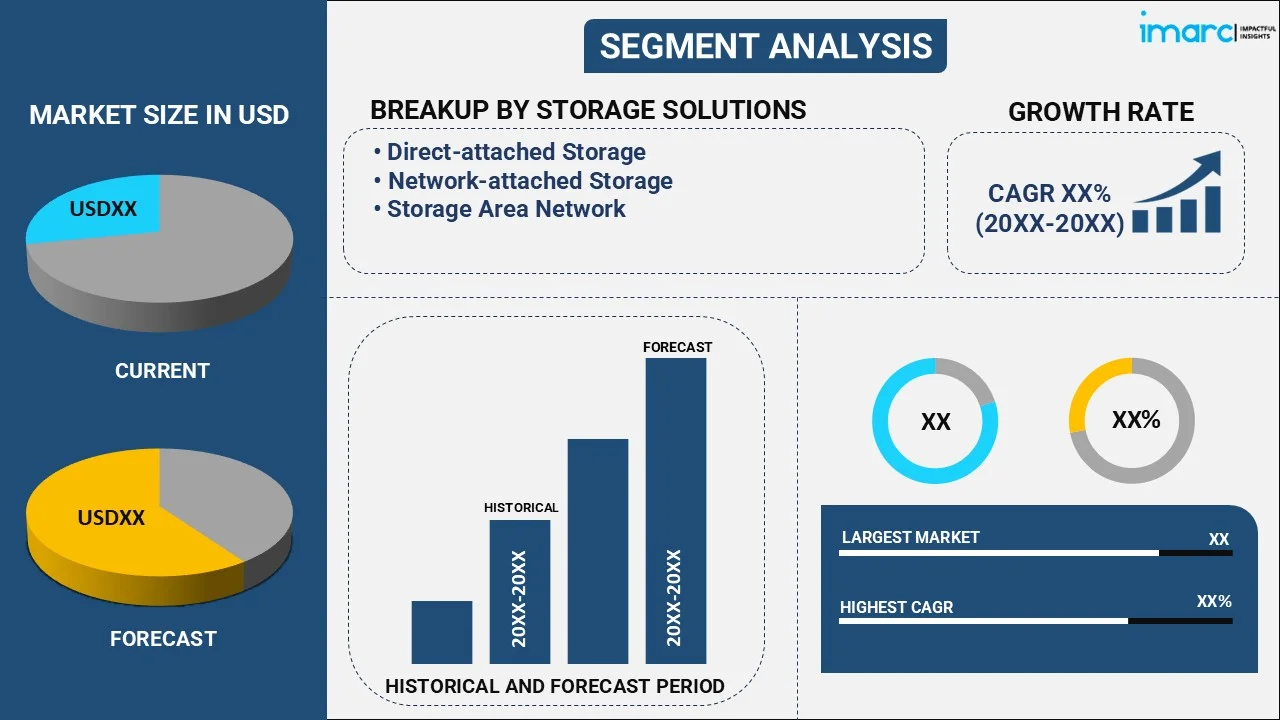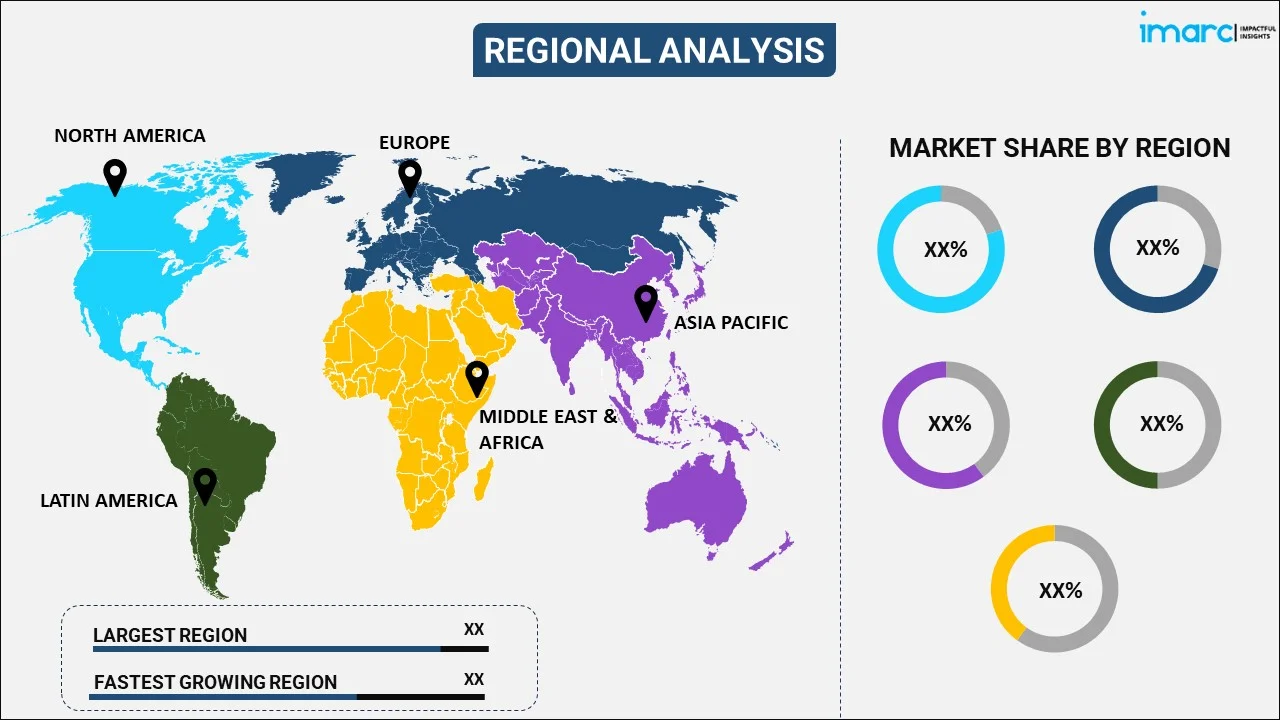
Media & Entertainment Storage Market Report by Storage Solution (Direct-attached Storage, Network-attached Storage, Storage Area Network), Deployment Mode (On-premises, Cloud-based, Hybrid), Storage Medium (HDD, SSD, Digital Tape, and Others), End User (Broadcast, Production and Post-Production, Media Agencies, Advertising, and Others), and Region 2025-2033
Market Overview:
The global media & entertainment storage market size reached USD 11.8 Billion in 2024. Looking forward, IMARC Group expects the market to reach USD 30.8 Billion by 2033, exhibiting a growth rate (CAGR) of 10.66% during 2025-2033. The surge in content creation, innovations in storage technologies, the advent of 4K, 8K, and other higher-resolution formats, growing adoption of cloud-based storage solutions, stricter data management and archival regulations, increasing consumer demand for high-quality and on-demand content, and strategic collaborations, are some of the major factors propelling the market.
|
Report Attribute
|
Key Statistics
|
|---|---|
|
Base Year
|
2024
|
|
Forecast Years
|
2025-2033
|
|
Historical Years
|
2019-2024
|
|
Market Size in 2024
|
USD 11.8 Billion |
|
Market Forecast in 2033
|
USD 30.8 Billion |
| Market Growth Rate 2025-2033 | 10.66% |
Media & entertainment storage refers to the specialized infrastructure designed to store, manage, and facilitate the rapid retrieval of large volumes of digital content critical to the media and entertainment sector. These industries are generating increasingly complex and high-resolution formats, such as 4K and 8K video, thus necessitating scalable, secure, and high-performance storage solutions. It can range from on-premises servers to cloud-based systems, depending on the specific requirements of a project or operation. It is crucial for the success of various workflows, from film production, and broadcasting, to content distribution, which hinges on the efficiency and reliability of these storage solutions.

The surging generation of content, including video, audio, and digital images, necessitates robust storage solutions, primarily driving the global media & entertainment storage market. In addition to this, ongoing innovations in storage technologies, such as solid-state drives and object storage, offer enhanced performance and scalability, thus strengthening the market growth. Concurrently, the advent of 4K, 8K, and even higher-resolution formats requires more storage capacity, thereby pushing the demand for advanced storage solutions. Besides this, the growing adoption of cloud-based storage solutions allows for cost-effective and scalable storage, attracting small and large enterprises in the media and entertainment sectors, which is contributing to the market growth. Moreover, stricter data management and archival regulations are compelling companies to invest in secure and compliant storage solutions, thereby boosting the market growth. Furthermore, increasing consumer demand for high-quality and on-demand content necessitates robust storage backends to ensure smooth delivery, which is aiding in market expansion.
Media & Entertainment Storage Market Trends/Drivers:
Rising demand for content
The exponential growth in content production is a pivotal driver for the media & entertainment storage market. As digital content consumption is rising among consumers, driven by the ubiquity of smart devices and the expansion of broadband internet services, the need for storage solutions grows correspondingly. Moreover, companies are producing more content and diversifying into various forms, including virtual reality experiences, interactive media, and real-time streaming. This diversification involves a greater variety of file types and sizes, all requiring unique storage specifications to efficiently manage data. Apart from this, live streaming events and 24/7 news cycles generate massive amounts of real-time data that require immediate storage capabilities. As a result, the demand for versatile, scalable, and high-speed storage solutions is at an all-time high in the media and entertainment industries.
Ongoing technological advancements
The advancement of technology is another crucial factor driving the growth of the media & entertainment storage market. Innovations such as solid-state drives (SSDs), object storage, and non-volatile memory express (NVMe) are transforming the landscape. These technologies provide the high-speed, low-latency performance that is crucial for media-related tasks like video editing, 3D rendering, and real-time analytics. Furthermore, technological advancements have made it possible to develop storage solutions that are more energy-efficient, more secure, and easier to manage. Companies are keen to leverage these new technologies to gain a competitive edge, whether it means faster time-to-market for their products or the ability to offer superior quality services to their customers. These technological advancements are creating a virtuous cycle of innovation and investment in the storage domain.
Introduction of high-resolution formats
High-resolution formats like 4K and 8K have become industry standards for various types of content, from feature films and television broadcasts to video games and virtual reality experiences. While these formats deliver unparalleled visual quality, they also require a significant amount of storage space. A single minute of 8K video can consume several gigabytes of storage. Consequently, media and entertainment companies need advanced storage solutions that can handle these enormous data volumes without compromising on speed or reliability. Moreover, the workflow involved in creating high-resolution content often necessitates specialized storage solutions that enable seamless collaboration among different teams and departments. The widespread adoption of high-resolution formats necessitates greater storage capacities and drives the demand for storage solutions optimized for the media and entertainment industry's unique needs.
Media & Entertainment Storage Industry Segmentation:
IMARC Group provides an analysis of the key trends in each segment of the market, along with forecasts at the global, regional and country levels from 2025-2033. Our report has categorized the market based on storage solution, deployment mode, storage medium, and end user.
Breakup by Storage Solution:

- Direct-attached Storage
- Network-attached Storage
- Storage Area Network
Direct-attached storage accounts for the majority of the market share
The report has provided a detailed breakup and analysis of the market based on the storage solution. This includes direct-attached storage, network-attached storage, and storage area network. According to the report, direct-attached storage represented the largest segment.
The growing demand for direct-attached storage (DAS) is contributing to the market growth as it offers low-latency performance, which is essential for real-time media editing and processing tasks. Besides this, the direct connection to the host system allows for high-speed data transfers, making it highly effective for time-sensitive operations, which increases its appeal. Furthermore, DAS solutions are generally easier to configure and manage, requiring less specialized expertise. This simplicity results in a lower total cost of ownership, making DAS an attractive choice for various media & entertainment storage organizations. Apart from this, with the increasing emphasis on data security and compliance, many businesses prefer DAS for its ability to provide localized and controlled storage environments, ensuring sensitive data remains within the organization's physical premises.
Breakup by Deployment Mode:
- On-premises
- Cloud-based
- Hybrid
On-premises holds the largest share in the industry
A detailed breakup and analysis of the market based on the deployment mode have also been provided in the report. This includes on-premises, cloud-based, and hybrid. According to the report, on-premises accounted for the largest market share.
On-premises storage offers a higher degree of control and customization, which is crucial for media companies handling sensitive or proprietary content. These systems ensure that the data resides within the physical confines of the organization, thereby providing an additional layer of security against data breaches. Concurrent with this, on-premises storage is often optimized for high-performance tasks specific to media production, such as video editing, that require rapid data retrieval capabilities, which is fueling the demand for on-premises storage solutions. Additionally, on-premise media and entertainment storage solutions are essential for maintaining data integrity, high-performance workflows, and stringent security measures in the industry.
Breakup by Storage Medium:
- HDD
- SSD
- Digital Tape
- Others
HDD represents the leading market segment
The report has provided a detailed breakup and analysis of the market based on the storage medium. This includes HDD, SSD, digital tape, and others. According to the report, HDD represented the largest segment.
Hard disk drives (HDDs) offer a high storage capacity at a relatively lower cost per gigabyte compared to other storage mediums like Solid-State Drives (SSDs). This cost-effectiveness is crucial for industries handling vast amounts of data, such as high-definition videos and complex graphics. In line with this, HDDs have matured as a technology, making them a reliable and well-understood storage medium, instilling confidence in their deployment for large-scale storage needs. Moreover, advances in HDD technology have also led to improvements in data transfer rates and durability. While alternative storage mediums are emerging, HDDs' established reliability and cost-effectiveness continue to make them a preferred choice in the media & entertainment storage market.
Breakup by End User:
- Broadcast
- Production and Post-Production
- Media Agencies
- Advertising
- Others
Production and Post-Production exhibit a clear dominance in the market
The report has provided a detailed breakup and analysis of the market based on the end user. This includes broadcast, production and post-production, media agencies, advertising, and others. According to the report, production and post-production represented the largest segment.
Production and post-production segments are driving the growth of the media & entertainment storage market primarily due to the data-intensive nature of their operations. These stages involve the capture, editing, and rendering of high-resolution digital content, processes that require immense storage capabilities. Besides this, the shift towards higher resolution formats, such as 4K and 8K, has further exacerbated the need for efficient and robust storage systems, creating a positive outlook for market growth. Beyond sheer capacity, these processes demand fast data transfer rates and real-time access to files to ensure seamless workflows and meet tight production timelines. Furthermore, post-production work often involves multiple iterations and the use of complex graphics, requiring even more specialized storage solutions, thereby strengthening the market growth.
Breakup by Region:

- North America
- United States
- Canada
- Asia Pacific
- China
- Japan
- India
- South Korea
- Australia
- Indonesia
- Others
- Europe
- Germany
- France
- United Kingdom
- Italy
- Spain
- Russia
- Others
- Latin America
- Brazil
- Mexico
- Others
- Middle East and Africa
North America leads the market, accounting for the largest media & entertainment storage market share
The market research report has also provided a comprehensive analysis of all the major regional markets, which include North America (the United States and Canada); Asia Pacific (China, Japan, India, South Korea, Australia, Indonesia, and others); Europe (Germany, France, the United Kingdom, Italy, Spain, Russia, and others); Latin America (Brazil, Mexico, and others); and the Middle East and Africa. According to the report, North America accounted for the largest market share.
North America holds a dominant position in the media & entertainment storage market, mainly due to the concentration of major media and entertainment companies, including film studios, broadcasters, and streaming services, in the region. The United States, in particular, is a hub for technological innovation and has a well-established infrastructure, which fosters the development and adoption of advanced storage solutions. In addition to this, high consumer demand for digital content, facilitated by widespread high-speed internet access, further fuels the need for robust storage systems. Moreover, stringent regulatory frameworks in North America also encourage data security and compliance, thus necessitating storage solutions that meet stringent requirements. Apart from this, the region's economic strength allows for significant investments in research and development, driving advancements in storage technology, which is propelling the market forward.
Competitive Landscape:
The competitive landscape of the global media and entertainment market is characterized by intense rivalry among a diverse range of companies across various segments. The leading market players are actively engaging in innovation, research and development (R&D) to offer advanced and scalable storage solutions. Besides this, they are also focusing on introducing products that provide high-speed data transfer, greater storage capacity, and superior reliability. Moreover, these companies are extensively partnering and collaborating to expand product offerings and reach a broader customer base. They are also investing in cloud-based solutions to meet the growing demand for remote accessibility and real-time collaboration. The key players are introducing cybersecurity features, customer support and after-sales services to ensure data integrity and compliance with regulatory standards and provide end-to-end solutions.
The market research report has provided a comprehensive analysis of the competitive landscape. Detailed profiles of all major companies have also been provided. Some of the key players in the market include:
- Amazon Web Services Inc. (Amazon.com Inc.)
- Cisco Systems Inc.
- Dell Technologies Inc.
- International Business Machines Corporation
- Microsoft Corporation
- NetApp Inc.
- Seagate Technology LLC
- Western Digital Corporation
(Please note that this is only a partial list of the key players, and the complete list is provided in the report.)
Recent Developments:
- In September 2023, AWS for Media & Entertainment announced the launch of a new Monetization solution, allowing customers to simplify and modernize their advertising, licensing, subscription, and marketing technology strategies.
- In May 2020, Dell Technologies and Google Cloud launched Dell Technologies Cloud OneFS for Google Cloud to allow organizations to control exponential data and application growth and ease the flow of files across their private clouds and Google Cloud.
- In August 2023, NetApp®, a global, cloud-led, data-centric software company, announced an extension of its partnership with Google Cloud to deliver new levels of storage performance combined with the simplicity and flexibility of the cloud.
Media & Entertainment Storage Market Report Scope:
| Report Features | Details |
|---|---|
| Base Year of the Analysis | 2024 |
| Historical Period | 2019-2024 |
| Forecast Period | 2025-2033 |
| Units | Billion USD |
| Scope of the Report | Exploration of Historical Trends and Market Outlook, Industry Catalysts and Challenges, Segment-Wise Historical and Future Market Assessment:
|
| Storage Solutions Covered | Direct-attached Storage, Network-attached Storage, Storage Area Network |
| Deployment Modes Covered | On-premises, Cloud-based, Hybrid |
| Storage Mediums Covered | HDD, SSD, Digital Tape, Others |
| End Users Covered | Broadcast, Production and Post-Production, Media Agencies, Advertising, Others |
| Regions Covered | Asia Pacific, Europe, North America, Latin America, Middle East and Africa |
| Countries Covered | United States, Canada, Germany, France, United Kingdom, Italy, Spain, Russia, China, Japan, India, South Korea, Australia, Indonesia, Brazil, Mexico |
| Companies Covered | Amazon Web Services Inc. (Amazon.com Inc.), Cisco Systems Inc., Dell Technologies Inc., International Business Machines Corporation, Microsoft Corporation, NetApp Inc., Seagate Technology LLC, Western Digital Corporation, etc. |
| Customization Scope | 10% Free Customization |
| Post-Sale Analyst Support | 10-12 Weeks |
| Delivery Format | PDF and Excel through Email (We can also provide the editable version of the report in PPT/Word format on special request) |
Key Benefits for Stakeholders:
- IMARC’s industry report offers a comprehensive quantitative analysis of various market segments, historical and current market trends, market forecasts, and dynamics of the media & entertainment storage market from 2019-2033.
- The research report provides the latest information on the market drivers, challenges, and opportunities in the global media & entertainment storage market.
- The study maps the leading, as well as the fastest-growing, regional markets. It further enables stakeholders to identify the key country-level markets within each region.
- Porter's five forces analysis assist stakeholders in assessing the impact of new entrants, competitive rivalry, supplier power, buyer power, and the threat of substitution. It helps stakeholders to analyze the level of competition within the media & entertainment storage market industry and its attractiveness.
- Competitive landscape allows stakeholders to understand their competitive environment and provides an insight into the current positions of key players in the market.
Key Questions Answered in This Report
The media & entertainment storage market was valued at USD 11.8 Billion in 2024.
The media & entertainment storage market is projected to exhibit a CAGR of 10.66% during 2025-2033, reaching a value of USD 30.8 Billion by 2033.
Key drivers of the media & entertainment storage market include the exponential surge in digital content creation and consumption, particularly high-resolution 4K/8K and immersive VR/AR formats; ongoing digital transformation with cloud/OTT growth; rapid technological advances in SSD, NVMe, and object storage; along with collaboration workflows and pandemic-driven demand spikes.
North America currently dominates the media & entertainment storage market due to booming high-def/4K-8K content production, streaming/OTT growth, cloud adoption with AI/ML integration, and enterprise-grade data protection/compliance infrastructure.
Some of the major players in the media & entertainment storage market include Amazon Web Services Inc. (Amazon.com Inc.), Cisco Systems Inc., Dell Technologies Inc., International Business Machines Corporation, Microsoft Corporation, NetApp Inc., Seagate Technology LLC, Western Digital Corporation, etc.
Need more help?
- Speak to our experienced analysts for insights on the current market scenarios.
- Include additional segments and countries to customize the report as per your requirement.
- Gain an unparalleled competitive advantage in your domain by understanding how to utilize the report and positively impacting your operations and revenue.
- For further assistance, please connect with our analysts.
 Request Customization
Request Customization
 Speak to an Analyst
Speak to an Analyst
 Request Brochure
Request Brochure
 Inquire Before Buying
Inquire Before Buying




.webp)




.webp)












